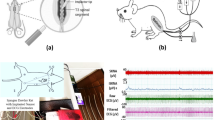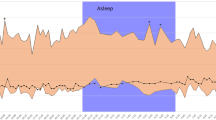Abstract
Introduction
Autonomic dysreflexia (AD) is a potentially life-threatening syndrome that can occur in patients with traumatic injury to the spinal cord; however, it has not been well described in patients with non-traumatic spinal cord injury (SCI) from cancer and its treatments.
Case presentation
We report four cases of autonomic dysreflexia secondary to primary spinal cord tumors and metastatic disease to the spine, and as sequela to cancer treatment. The clinical characteristics, diagnostic considerations, and therapeutic strategies used to mitigate the symptoms are discussed.
Discussion
The case series shows that AD is a rare but important condition to consider among patients with cancer-related SCI. There is a need for close monitoring and early identification of this syndrome in this population. Therapeutic strategies are available to mitigate these symptoms and risks of complications.
This is a preview of subscription content, access via your institution
Access options
Subscribe to this journal
Receive 1 print issues and online access
We are sorry, but there is no personal subscription option available for your country.
Buy this article
- Purchase on SpringerLink
- Instant access to full article PDF
Prices may be subject to local taxes which are calculated during checkout
Similar content being viewed by others
References
Lee BY, Karmakar MG, Herz BL, Sturgill RA. Autonomic dysreflexia revisited. J Spinal Cord Med. 1995;18:75–87. https://doi.org/10.1080/10790268.1995.11719383.
Valles M, Benito J, Portell E, Vidal J. Cerebral hemorrhage due to autonomic dysreflexia in a spinal cord injury patient. Spinal Cord. 2005;43:738–40. https://doi.org/10.1038/sj.sc.3101780.
Kiker JD, Woodside JR, Jelinek GE. Neurogenic pulmonary edema associated with autonomic dysreflexia. J Urol. 1982;128:1038–9. https://doi.org/10.1016/s0022-5347(17)53334-0.
Dolinak D, Balraj E. Autonomic dysreflexia and sudden death in people with traumatic spinal cord injury. Am J Forensic Med Pathol. 2007;28:95–8. https://doi.org/10.1097/PAF.0b013e3180600f99.
Colachis SC 3rd. Autonomic hyperreflexia with spinal cord injury. J Am Paraplegia Soc. 1992;15:171–86. https://doi.org/10.1080/01952307.1992.11735871.
Bycroft J, Shergill IS, Chung EA, Arya N, Shah PJ. Autonomic dysreflexia: a medical emergency. Postgrad Med J. 2005;81:232–5. https://doi.org/10.1136/pgmj.2004.024463.
Karlsson AK. Autonomic dysreflexia. Spinal Cord. 1999;37:383–91. https://doi.org/10.1038/sj.sc.3100867.
Kirshblum S, Campagnolo DI, DeLisa JA. Spinal cord medicine. x. Lippincott Williams & Wilkins; 2002. p. 655.
Helkowski WM, Ditunno JF Jr., Boninger M. Autonomic dysreflexia: incidence in persons with neurologically complete and incomplete tetraplegia. J Spinal Cord Med. 2003;26:244–7. https://doi.org/10.1080/10790268.2003.11753691.
Teasell RW, Arnold JM, Krassioukov A, Delaney GA. Cardiovascular consequences of loss of supraspinal control of the sympathetic nervous system after spinal cord injury. Arch Phys Med Rehabil. 2000;81:506–16. https://doi.org/10.1053/mr.2000.3848.
Kirshblum SC, Priebe MM, Ho CH, Scelza WM, Chiodo AE, Wuermser LA. Spinal cord injury medicine. 3. Rehabilitation phase after acute spinal cord injury. Arch Phys Med Rehabil. 2007;88:S62–70. https://doi.org/10.1016/j.apmr.2006.12.003.
New PW, Cripps RA, Bonne Lee B. Global maps of non-traumatic spinal cord injury epidemiology: towards a living data repository. Spinal Cord. 2014;52:97–109. https://doi.org/10.1038/sc.2012.165.
New PW, Marshall R. International Spinal Cord Injury Data Sets for non-traumatic spinal cord injury. Spinal Cord. 2014;52:123–32. https://doi.org/10.1038/sc.2012.160.
McKinley WO, Seel RT, Hardman JT. Nontraumatic spinal cord injury: incidence, epidemiology, and functional outcome. Arch Phys Med Rehabil. 1999;80:619–23. https://doi.org/10.1016/s0003-9993(99)90162-4.
Saito H. Autonomic dysreflexia in a case of radiation myelopathy and cisplatin-induced polyneuropathy. Spinal Cord Ser Cases. 2020;6:71 https://doi.org/10.1038/s41394-020-00322-0.
Mizuno H, Honda F, Ikota H, Yoshimoto Y. Autonomic dysreflexia associated with cervical spinal cord gliofibroma: case report. BMC Neurol. 2021;21:252 https://doi.org/10.1186/s12883-021-02271-z.
Abdou CA, Wolff EH, Tracey AT, Klausner AP. Metastatic melanoma to the bladder presenting as autonomic dysreflexia in a patient with paraplegia. Urol Case Rep. 2021;39:101820 https://doi.org/10.1016/j.eucr.2021.101820.
Mansueto P, Seidita A, D’Alcamo A, Carroccio A. Role of FODMAPs in Patients With Irritable Bowel Syndrome. Nutr Clin Pract. 2015;30:665–82. https://doi.org/10.1177/0884533615569886.
Curt A, Nitsche B, Rodic B, Schurch B, Dietz V. Assessment of autonomic dysreflexia in patients with spinal cord injury. J Neurol Neurosurg Psychiatry. 1997;62:473–7. https://doi.org/10.1136/jnnp.62.5.473.
Gedde MH, Lilleberg HS, Assmus J, Gilhus NE, Rekand T. Traumatic vs non-traumatic spinal cord injury: A comparison of primary rehabilitation outcomes and complications during hospitalization. J Spinal Cord Med. 2019;42:695–701. https://doi.org/10.1080/10790268.2019.1598698.
Wecht JM, et al. International Standards to document Autonomic Function following SCI (ISAFSCI): Second Edition. Top Spinal Cord Inj Rehabil. 2021;27:23–49. https://doi.org/10.46292/sci2702-23.
Krassioukov A, et al. Evaluation and Management of Autonomic Dysreflexia and Other Autonomic Dysfunctions: Preventing the Highs and Lows: Management of Blood Pressure, Sweating, and Temperature Dysfunction. Top Spinal Cord Inj Rehabil. 2021;27:225–90. https://doi.org/10.46292/sci2702-225.
Stubblefield MD, Bilsky MH. Barriers to rehabilitation of the neurosurgical spine cancer patient. J Surg Oncol. 2007;95:419–26. https://doi.org/10.1002/jso.20783.
Funding
This case series was supported in part by a Cancer Center Support Grant (P30 CA008748) to Memorial Sloan Kettering Cancer Center (MSKCC) from the National Institutes of Health/National Cancer Institute and the Biomarker Development Program at MSKCC.
Author information
Authors and Affiliations
Contributions
Statement Each person listed as an author has participated in the case series and manuscript significantly. EQ performed chart review and lead the writing of the manuscript. GM performed chart review and contributed meaningfully to the manuscript and reviewed the final version. LR assisted in developing the manuscript idea, contributed to the final manuscript and supervised the project.
Corresponding author
Ethics declarations
Competing interests
The authors declare no competing interests.
Additional information
Publisher’s note Springer Nature remains neutral with regard to jurisdictional claims in published maps and institutional affiliations.
Rights and permissions
Springer Nature or its licensor (e.g. a society or other partner) holds exclusive rights to this article under a publishing agreement with the author(s) or other rightsholder(s); author self-archiving of the accepted manuscript version of this article is solely governed by the terms of such publishing agreement and applicable law.
About this article
Cite this article
Qin, E., Marshall, G.M. & Ruppert, L. Autonomic dysreflexia in patients with cancer and spinal cord injury: a case series. Spinal Cord Ser Cases 10, 66 (2024). https://doi.org/10.1038/s41394-024-00678-7
Received:
Revised:
Accepted:
Published:
DOI: https://doi.org/10.1038/s41394-024-00678-7



